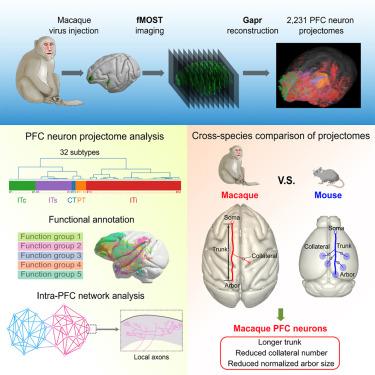Single-neuron projectomes of macaque prefrontal cortex reveal refined axon targeting and arborization
IF 42.5
1区 生物学
Q1 BIOCHEMISTRY & MOLECULAR BIOLOGY
引用次数: 0
Abstract
Cortical expansion endows advanced cognitive functions in primates, and whole-brain single-neuron projection analysis helps to elucidate underlying neural circuit mechanisms. Here, we reconstructed 2,231 single-neuron projectomes for the macaque prefrontal cortex (PFC) and identified 32 projectome-based subtypes of intra-telencephalic, pyramidal-tract, and cortico-thalamic neurons. Each subtype exhibited distinct topography in their soma distribution within the PFC, a characteristic pattern of axon targeting, and subregion-specific patchy terminal arborization in the targeted area, with putative functions annotated. Furthermore, we identified a subdomain connectivity network and extensive local axons within the PFC. Compared with those in mice, macaque PFC projectomes exhibited a similar topographic gradient of terminal arborization at the targeted regions but much higher target specificity, fewer collaterals, and smaller brain size-normalized arbors. Thus, whole-brain single-axon macaque projectomes revealed highly refined axon targeting and arborization, providing key insights into the structural basis for complex brain functions in primates.

猕猴前额叶皮层的单神经元项目揭示了精细的轴突靶向和树突化
皮层扩张赋予灵长类动物高级认知功能,全脑单神经元投射分析有助于阐明潜在的神经回路机制。在这里,我们重建了猕猴前额叶皮层(PFC)的2231个单神经元项目组,并确定了端脑内、锥体束和皮质丘脑神经元的32个基于项目组的亚型。每个亚型在PFC内的胞体分布中表现出不同的地形,轴突靶向的特征模式,以及靶区域特定的斑块状终末乔木化,并注释了假设的功能。与小鼠相比,猕猴PFC项目组在目标区域表现出相似的末端乔木的地形梯度,但目标特异性更高,侧枝更少,脑尺寸标准化乔木更小。因此,猕猴全脑单轴突项目组揭示了高度精细的轴突靶向和树突化,为了解灵长类动物复杂脑功能的结构基础提供了关键见解。
本文章由计算机程序翻译,如有差异,请以英文原文为准。
求助全文
约1分钟内获得全文
求助全文
来源期刊

Cell
生物-生化与分子生物学
CiteScore
110.00
自引率
0.80%
发文量
396
审稿时长
2 months
期刊介绍:
Cells is an international, peer-reviewed, open access journal that focuses on cell biology, molecular biology, and biophysics. It is affiliated with several societies, including the Spanish Society for Biochemistry and Molecular Biology (SEBBM), Nordic Autophagy Society (NAS), Spanish Society of Hematology and Hemotherapy (SEHH), and Society for Regenerative Medicine (Russian Federation) (RPO).
The journal publishes research findings of significant importance in various areas of experimental biology, such as cell biology, molecular biology, neuroscience, immunology, virology, microbiology, cancer, human genetics, systems biology, signaling, and disease mechanisms and therapeutics. The primary criterion for considering papers is whether the results contribute to significant conceptual advances or raise thought-provoking questions and hypotheses related to interesting and important biological inquiries.
In addition to primary research articles presented in four formats, Cells also features review and opinion articles in its "leading edge" section, discussing recent research advancements and topics of interest to its wide readership.
 求助内容:
求助内容: 应助结果提醒方式:
应助结果提醒方式:


